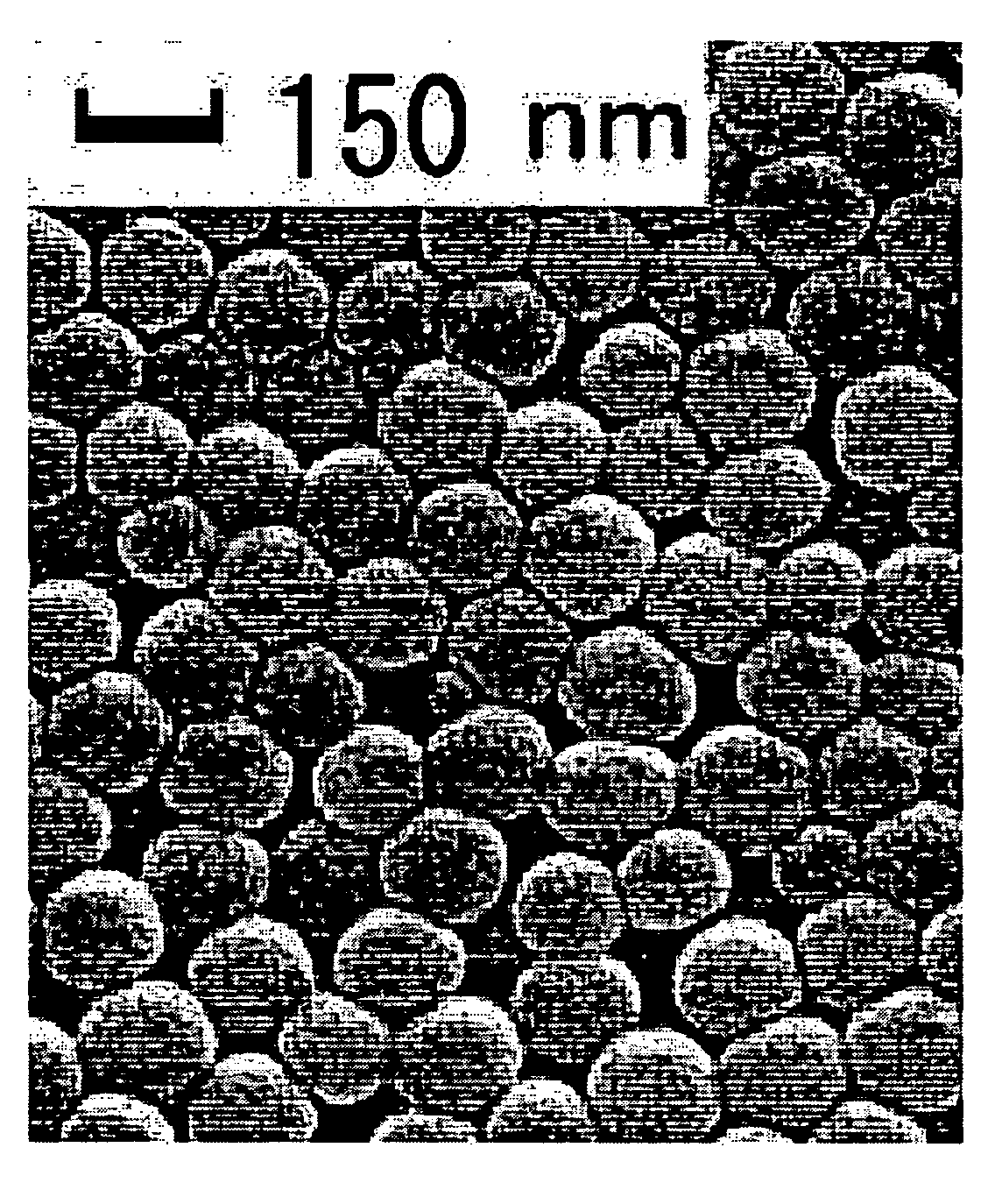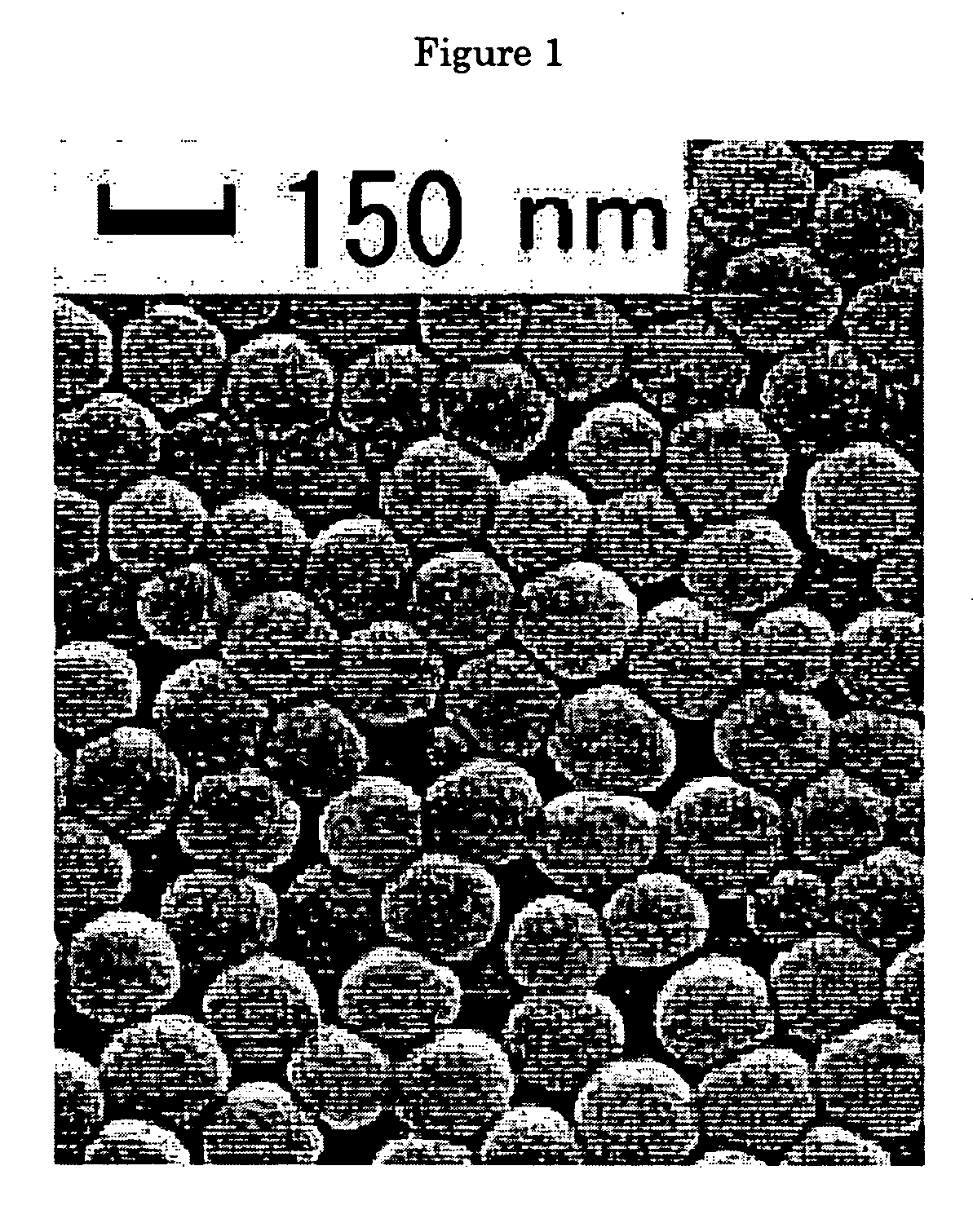Ink-jet recording medium and process for producing the same
- Summary
- Abstract
- Description
- Claims
- Application Information
AI Technical Summary
Benefits of technology
Problems solved by technology
Method used
Image
Examples
synthesis example 1
A Dispersion of Fine Cationic Polymer Particles
[0051] Three hundred and ten parts of water, 9 parts of 30% octadecyl trimethyl ammonium chloride [cation AB: a trade name of NOF CORPORATION, cationic emulsifier (does not contribute to the reaction)], 32 parts of a 50% aqueous acrylamide solution, 1 part of thioglycolic acid, 14 parts of 80% methacryloyloxyethyl trimethyl ammonium chloride, 86 parts of styrene and 46 parts of methyl methacrylate were added to a reactor equipped with an agitator, a dropping addition tank and a thermometer, and the contents were heated to 60° C. while bubbling in nitrogen gas. Next, 12 parts of a 4% aqueous solution of 2,2-azo-bis-2-amidinopropane dihydrochloride (V-50: a trade name of Wako Pure Chemical Industries, Ltd.) was added to initiate a polymerization. An exothermic polymerization occurred, the reaction mixture was maintained at 85° C. for an hour, 2 parts of a 4% aqueous solution of 2,2-azo-bis-2-amidinopropane dihydrochloride was added, and ...
synthesis example 2
A Dispersion of Fine Cationic Polymer Particles
[0052] Three hundred and thirty parts of water, 6.5 parts of acetic acid, 6.4 parts of 30% cetyl trimethyl ammonium chloride (quartamin 60W: a trade name of Kao Corporation, cationic emulsifier), 16 parts of a 50% aqueous acrylamide solution, 16 parts of N,N-dimethyl aminoethyl methacrylate, 1 part of thioglycolic acid, 64 parts of styrene, 61 parts of methyl methacrylate and 11 parts of N-butyl acrylate were added to a reactor equipped with an agitator and a thermometer, and the mixture were heated to 60° C. while bubbling in nitrogen gas. Next, 4.2 parts of a 6% aqueous solution of 2,2-azo-bis-2-amidinopropane dihydrochloride (V-50: a trade name of Wako Pure Chemical Industries, Ltd.) was added to initiate a polymerization. An exothermic polymerization occurred and the reaction mixture was maintained at 85° C. for an hour after which 3.7 parts of 3% 2,2-azo-bis-2-amidinopropane dihydrochloride aqueous solution was added and the react...
synthesis example 3
A Dispersion of Fine Cationic Polymer Particles
[0053] Three hundred parts of water, 0.5 part of acetic acid, 9 parts of 30% cetyl trimethyl ammonium chloride (quartamin 60W: a trade name of Kao Corporation, cationic emulsifier), 16 parts of a 50% aqueous acrylamide solution, 1 part of thioglycolic acid and 20 parts of 80% methacryloyloxyethyl trimethyl ammonium chloride were added to a reactor equipped with an agitator, a droppnig addition tank and a thermometer, and the mixture were heated to 80° C. while bubbling in nitrogen gas. In this mixture, 136 parts of a mixture of 78 parts of styrene, 42 parts of methyl methacrylate and 16 parts of n-butyl acrylate was added by drops over 2 hours while simultaneously adding by drops 16 parts of a 4% aqueous solution of 2,2-azo-bis-2-amidinopropane dihydrochloride (V-50: a trade name of Wako Pure Chemical Industries, Ltd.). The reaction mixture was maintained for 2 hours at 85° C., and then 2 parts of 4% 2,2-azo-bis-2-amidinopropane dihydr...
PUM
| Property | Measurement | Unit |
|---|---|---|
| Temperature | aaaaa | aaaaa |
| Fraction | aaaaa | aaaaa |
| Percent by mass | aaaaa | aaaaa |
Abstract
Description
Claims
Application Information
 Login to View More
Login to View More - R&D
- Intellectual Property
- Life Sciences
- Materials
- Tech Scout
- Unparalleled Data Quality
- Higher Quality Content
- 60% Fewer Hallucinations
Browse by: Latest US Patents, China's latest patents, Technical Efficacy Thesaurus, Application Domain, Technology Topic, Popular Technical Reports.
© 2025 PatSnap. All rights reserved.Legal|Privacy policy|Modern Slavery Act Transparency Statement|Sitemap|About US| Contact US: help@patsnap.com


